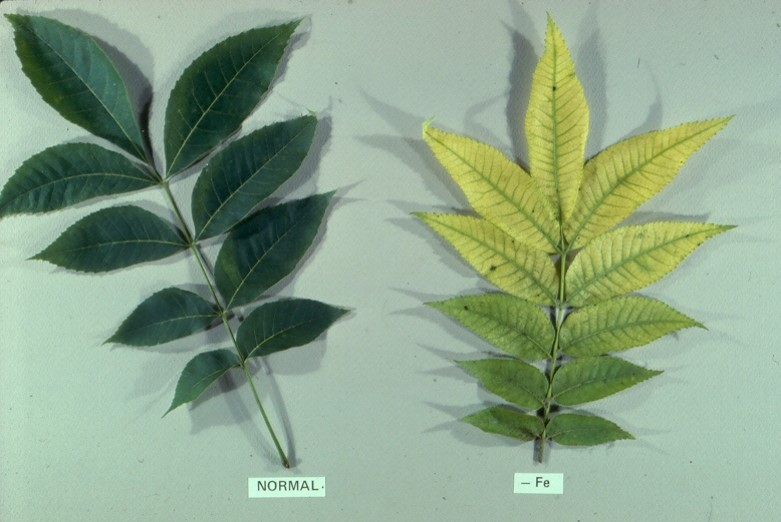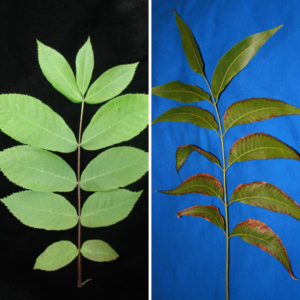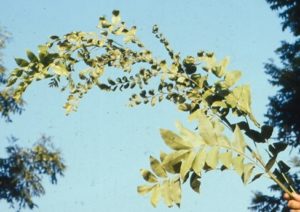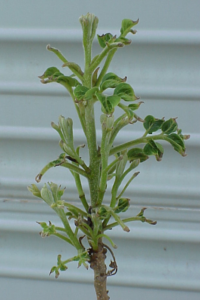Micronutrients for pecans, just a little makes all the difference

The iron deficient leaf on the right has interveinal chlorosis with the veins maintaining their green color. (Photo courtesy of Charlie Graham)
These 17 essential elements, also called nutrients, are often split into three groups. The first group is the three macronutrients that plants can obtain from water, air, or both— carbon, hydrogen, and oxygen. They are readily available and don’t have to be acquired from the soil, so these macronutrients are not sold as fertilizers down at the co-op. The remaining 14 essential elements are generally divided into two groups—soil-derived macronutrients and soil-derived micronutrients. This split is based on the actual amount of nutrients required for adequate plant growth. The soil-derived macronutrients are nitrogen, phosphorus, potassium, sulfur, calcium, and magnesium. The soil-derived micronutrients are boron, chlorine, copper, iron, manganese, molybdenum, nickel, and zinc.
To prepare for this discussion, it would probably be helpful to go back and read “Liebig’s Law of the Minimum” in Pecan South’s January 2017 edition. The “theory of minimum” in agricultural chemistry was developed by German botanist Philipp Carl Sprengel and popularized by the German chemist Justus Freiherr von Liebig. Sprengel’s “theory of minimum” states that plant growth is limited by the essential nutrient at the lowest concentration. Increasing nutrients that were already available in plentiful amounts did not increase plant growth. Only by increasing the available quantity of the limiting essential nutrient (the least abundant in relation to “plant need”) was the growth of a plant or crop improved. So, even though plants only need a few parts per million (ppm) of nickel or molybdenum, they can’t grow normal without it.
Macronutrients such as nitrogen, phosphorus, and potassium tend to garner most of the attention when fertilizers are discussed. And even some micronutrients, like zinc, get their fair share of attention (four articles in Pecan South in 2020). I thought it would be a good idea to discuss the other micronutrients because they are important too!
Chlorine
I will not spend a lot of time on chlorine because a pecan grower will probably never see a tree with chlorine deficiency in their lifetime. Chlorine is ubiquitous in nature and is supplied to the plant from soil reserves, irrigation water, rain, fertilizers, and air pollution. It is highly mobile in the soil and is readily taken up by plants in quantities 10 to 100 times greater than what is needed for normal growth. Typically, we are much more concerned about chlorine toxicity than we are with plants being deficient. It is an essential nutrient in photosynthesis, activates the proton pumping ATPase at the tonoplast, and is involved in the opening and closing of stomata. Chlorine, therefore, plays several important roles in plant physiology, so it’s good that it is always in adequate supply.

Left to right: Boron deficiency in pecans on left versus boron toxicity on pecan leaves. (Photo courtesy of Charlie Graham)
Boron
Deficiency symptoms for boron would be expected at leaf concentrations less than 15 ppm. Plant deficiency in boron leads to auxin accumulation at the growing tips, which results in abnormal growth. The apical tips become deformed, and the leaves and stems become brittle. Healthy pecan leaves should have 15 to 50 ppm of boron. Georgia has reported that concentrations between 50 and 100 ppm can improve pecan production by increasing nut retention and enhancing nut shell out.
Boron moves in the soil by mass flow and diffusion, with boron deficiency occurring when soil moisture levels are low for extended periods or after a long period of heavy leaching rainfall. Boron deficiency is likely to occur on sandy low organic matter content soils as well as organic soils. Soil-applied boron normally lasts for only one year since boron is rapidly leached by rainfall and irrigation.
A major concern with regard to boron nutrition is the potential for toxicity. Pecan and many other fruit crops (apple, blackberry, grape, and peach) are sensitive to higher boron levels. Boron accumulates in the leaf margins and can lead to marginal burning and death of the leaf margins. Irrigation water containing greater than 2 ppm of boron often leads to toxicity systems, depending on the frequency of water application. Boron fertilization is often more safely applied as a foliar spray than as a soil application.
Boron has long been associated with pollen germination and growth and improves the stability of pollen tubes. Inadequate boron can cause the germ tube to rupture, leading to reduced fertilization. Boron functions primarily in the cell wall structure and the pectic substances associated with it, and aids in carbohydrates’ movement across cell walls. Boron is believed to be important in the synthesis of one of the bases for RNA (uracil) formation and in cellular activities (division, differentiation, maturation, respiration, growth, etc.).
Iron
Compared to boron, iron concentrations in leaf tissue are generally higher, ranging from 50 to 300 ppm. Iron deficiency is typically induced by one of several factors such as excessive lime application; cold, wet spring weather; rootstock; or high soil concentrations of zinc, phosphorous or manganese. Excessive irrigation coupled with poorly drained soils can also induce iron deficiency. The deficiency generally occurs early in the growing season during the spring flush and disappears as growth slows down in the summer.
Iron is not mobile in plants, so deficiencies first appear on younger leaves. The interveinal chlorosis is contrasted by pronounced green venation. However, in severe cases, the young leaves are light yellow to white with no venation. Severe cases of iron deficiency may also be confused with nitrogen deficiency. Symptoms are spatially variable, with only some trees or only some limbs in a tree showing symptoms. Treatment is typically by foliar application of iron chelates, but soil applications of Fe-EDDHA chelated fertilizers have proven successful.
Iron is a component of several molecules that help carry out photosynthesis and is also involved in the biosynthesis of chlorophyll. It is a protein ferredoxin component and is required for nitrate and sulfate reduction and energy (NADP) production.
Manganese
Manganese is not mobile in plants, so deficiencies appear first in the youngest plant tissue. Visible manganese deficiency symptoms include general leaf chlorosis or interveinal leaf chlorosis. In high pH soils, most manganese is insoluble and unavailable, but as the soil becomes more acidic, manganese increases in solubility and availability. Pecan leaves generally contain between 100 to 1000 ppm of manganese.
Pecan orchards located on acidic soils are more likely to have toxicity problems than deficiency issues. Manganese toxicity can occur in soils when the soil pH is less than 5.0. High soil test manganese levels are easily decreased by bringing the soil pH to the level recommended for the crop. Calcium appears to protect against high manganese levels. In central Louisiana, it was not unusual to see leaf concentrations of manganese above 2000 ppm, but with over 2 percent calcium with no visible toxicity symptoms.
Manganese occurs in multiple oxidation states and therefore plays an important role in redox processes. It is a part of superoxide dismutase which protects pecans from oxygen free radicals. Manganese is a cofactor and is involved in the activation of over 35 enzymes. Manganese is involved in photosystem II, in which oxygen gas is released when water is split.
Copper
Copper is not very mobile in plants; so, deficiency symptoms appear first in the youngest plant tissue. Copper is also immobile in the soil, and plant availability is decreased by liming and the use of phosphate fertilizers. High zinc levels in the soil can inhibit copper uptake. Mineral soils with pH values exceeding 7.5 may have poor copper availability. Pecan leaves should contain 6 to 30 ppm of copper.
Copper deficiency results in a rapid decline in copper enzyme activity, resulting in distinct metabolic changes and a reduction in plant growth. Many of these enzymes are involved in photosynthesis and cellular respiration. Insufficient levels of copper also negatively impact carbohydrate and protein metabolism.

The initial flush of leaves appears normal, while the mid-section shows symptoms of both copper and molybdenum deficiency. (Photos courtesy of Charlie Graham)
Molybdenum
The requirement for molybdenum in pecan is lower than for any other essential nutrient, except possibly nickel. Soil pH is the major soil factor affecting molybdenum plant availability. Availability, and therefore content, in plants increases as the soil pH increase from low acidity (<pH 6.0) to neutrality (>7.0 pH). Sulfate and molybdate are strongly competing anions during uptake by the roots. Therefore, the application of sulfate-containing fertilizers such as gypsum and ammonium sulfate can induce molybdenum deficiency. Due to molybdenum’s high phloem mobility, foliar applications are typically used to alleviate deficiencies.
Molybdenum is required by plants for proper nitrogen metabolism, being a component of the enzymes nitrate reductase and nitrogenase. In pecans, nitrate reductase is involved in the reduction of nitrate-N to ammoniacal-N. For growers utilizing legumes in your orchard, nitrogenase is an enzyme used by nitrogen-fixing bacteria to convert atmospheric N2 gas to ammonia in the root nodules. Therefore, molybdenum deficiency can have a direct or indirect impact on pecan trees’ nitrogen nutrition.
Nickel
Meet the new kid on the block. Most older fertilizer recommendations for pecan will not even mention this nutrient. While foliar nickel requirements are low, 2-2.5 ppm, depending on the state recommendations, it is still an essential element for normal plant growth. The nickel content in the soil is highly correlated with that in the plant, as nickel is readily and rapidly taken up by plants and is highly mobile in plants. Liming is one means of reducing nickel availability. Georgia generally attributes much of their deficiency problems to heavy applications of zinc over many years. Additionally, high soil manganese levels may also induce nickel deficiency symptoms.

Severe nickel deficiency of seedling pecan leaves grown in artificial media in the greenhouse. (Photo courtesy of Charlie Graham)
A deficiency of nickel is responsible for the condition known as mouse ear in pecan. It is fairly common in container-grown pecan trees and has been reported in field-grown pecan trees in Georgia. It generally first appears on the spring flush of growth on young trees. The most common symptom of mouse ear is a rounded or blunt leaflet tip, but in severe cases, leaves may not develop at all. Growers can easily rectify nickel deficiency by applying a single foliar nickel fertilizer application in the fall or spring.
Nickel is a functional constituent in eight enzymes, but for higher plants, including pecan, urease is the enzyme of interest. The urease enzyme in plants requires nickel for the efficient conversion of urea to ammonia, a usable form of nitrogen for the plant. When nickel is at an insufficient level in the plant, urea is not converted as efficiently, and a toxic buildup of urea may occur. Being aware of this process would be especially important if you were applying foliar urea nitrogen sprays, where foliar toxicity symptoms would be related to the tree’s nickel nutritional status.
It is a common practice to include UAN (urea/ammonium nitrate) in foliar zinc sprays. Nickel deficient pecan plants also accumulated higher levels of organic acids than nickel sufficient plants, specifically lactic and oxalic acid. These accumulations disrupted normal metabolite conversion necessary for normal plant growth and development. Just as with molybdenum, for growers using legumes in your orchards, nickel deficiency also impacts nitrogen fixation by bacterial symbionts.
Summary
Unlike macronutrients, micronutrients’ foliar applications are the most effective method to maintain optimum levels or correct deficiencies in pecan orchards. Even though soil applications of boron can be effective, they are risky; so, foliar sprays are more manageable.
Effective foliar application of micronutrients is dependent on spray coverage, the drying time of the spray solution, the optimum concentration of the micronutrient, appropriate formulation of the nutrient, and optimum spraying conditions (temperature, wind speed, droplet size, etc.).
If this article has piqued your interest in plant nutrition, there are many good books available to broaden your knowledge, including Mineral Nutrition of Higher Plants by Horst Marschner and Mineral Nutrition of Plants: Principles and Perspectives by Emanuel Epstein and Arnold J. Bloom.

